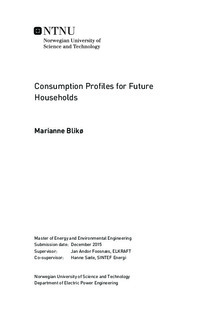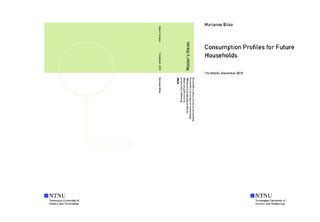| dc.description.abstract | Over the last few years there has been a change in energy consumption in Norwegian households. New houses are far better insulated, have high demands for efficient energy carriers and new installations that affect the electricity consumption. Today, most of the electricity in a Norwegian household is used for space heating, but this demand is expected to be reduced in the future, mainly because the need for space heating is reduced as a result of stricter demands for isolation. Electricity consumption in general will also be reduced as new appliances are becoming more energy efficient. Peak power demand caused by new installations is a challenge. The duration of and whether demand occurs simultaneously in several households is crucial for if constrains will occur and how the problems can be managed. Some appliances, such as hot fill dishwashers and washing machines have much lower energy consumption than traditional machines and can use water heated by for instance solar collectors. Local energy production, for example from sun energy, will help reduce both energy and electricity demand in a household.
To give specific examples of how consumption profiles for future households can look, a numerical analysis on a group consisting of 24 households has been completed. One of the customers was selected for further analysis, and this customer s consumption in a given week is selected as the basis for examples of future consumption profiles. The customer has been fitted with a fictional electric vehicle, household battery and solar panel.
The analysis shows that local energy production from solar insulation often corresponds poorly with the household s demand. The energy is mostly supplied during daytime, while the greatest demand occurs early mornings or during the afternoon. This results in customers sometimes having excess electricity production. This excess energy can be sold back to the grid if customers are prosumers, but in the way this is arranged today, customers will earn less on selling the electricity than they would have had to pay to buy it. As this prosumer scheme is not particularly attractive, the option to store energy in a battery is investigated.
The examined battery has a storage capacity of 7 kWh and a power of 3.3 kW. It turns out that during the particular week the solar panels produced more energy than the battery could store. This means that the customer cannot utilize the produced energy at any time, only for short periods at a time. Even with energy storage during daytime the panels still produce more energy than the customer s demand at this time, so an already low consumption during daytime becomes even more reduced.
The analysis shows that using batteries to reduce demand created by an electric vehicle will contribute little to solving network problems related to peak load. The customer will not be able to earn back the large investment cost for the battery only by storing self-produced energy. This is because the power demand while charging an electric vehicle is much higher than the power the battery can deliver. A battery that will deal with high local generation and high power demand from electric vehicles would require both higher energy and power capacity than the battery that was investigated in this thesis.
The analysis showed that the battery could be useful in one scenario: When used to reduce the cost of high power demand, if new power tariffs were introduced. In general, an analysis carried out regarding new network tariffs shows that customers have great saving potentials if this is introduced. A prerequisite if the new tariffs are going to help solve the problems in the network is that they are comprehensible to customers and that the customers are aware of how their consumption affects their costs. | |

